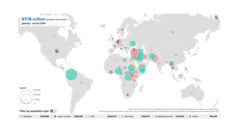Fueled by the abuse of prescription opioids, the rate of drug overdose fatalities increased by 137 percent in the United States between 2000 and 2014. In 2014 alone, there were over 47,000 drug overdose deaths, making it the deadliest year on record up to that point (it has since climbed to over 60,000). These dramatic increases in drug overdoses have coincided with equally significant trends in unauthorized immigration. Between 1990 and 2014, the population of undocumented immigrants more than tripled, from 3.5 million to 10.9 million.
The juxtaposition of these two social changes have sparked considerable controversy as to whether undocumented immigration leads to worsening drug problems. For example, President Trump has repeatedly suggested that immigration enforcement is key to stemming the overdose crisis. Politicians have also linked alcohol problems to undocumented immigration. Representative Steve King of Iowa, for example, has claimed that undocumented drunk drivers kill 13 Americans every day.
However, the debate—both public and political—on the supposed connection between undocumented immigration and drug/alcohol problems has far outpaced the research in this area. This is partly due to data limitations, as researchers have not had access to reliable counts of the undocumented population. Using newly developed state-level estimates of the undocumented population between 1990 and 2014 from the Center for Migration Studies and Pew Research Center, in a recent study, my colleagues and I provided the first systematic investigation into the relationship between undocumented immigration and drug and alcohol problems.
From a policy perspective, these findings undermine arguments that the deportation of unauthorized immigrants will lead to significant reductions in either drug overdoses or drunk driving.
The results largely contradict the rhetoric. We found that increased undocumented immigration was significantly associated with reductions in drug arrests, drug overdose deaths, and drunk driving arrests, net of other factors such as poverty and unemployment. In terms of drunk driving deaths, there was virtually no association between DUI fatalities and undocumented immigration.
The “immigrant paradox” might help us understand these trends. Stated briefly, immigrants tend to be engaging in less crime and staying healthier than we would expect based on their socioeconomic disadvantages, such as low levels of education and limited economic resources. It could also be the case that undocumented immigrants avoid drugs and are less likely to drive drunk, or drive at all, for fear of police surveillance and deportation.
From a policy perspective, these findings undermine arguments that the deportation of unauthorized immigrants will lead to significant reductions in either drug overdoses or drunk driving. In this regard, our study serves as a cautionary tale of the pitfalls when policy debates are divorced from empirical evidence. In the case of the opioid epidemic, undocumented immigration appears to be a red herring.
However, there are policy levers that can be pulled to help reduce overdose deaths. The Centers for Disease Control (CDC) have developed several prevention and intervention efforts, ranging from reducing public exposure to opioids, expanding access to treatment, and implementing drug-monitoring programs to prevent abuse. In addition, the National Institute for Drug Abuse (NIDA) has developed guidelines for effective prevention and treatment of substance abuse based on the best available evidence to date. With the recent declaration of the opioid epidemic as a public health emergency, our hope is that emphasis will be placed on the CDC and NIDA recommendations, rather than channeled to concerns unsupported by the data. With drug overdoses now the leading cause of death among Americans under 50, the public health consequences of doing anything otherwise could be immense.
Feature image: Greg Matthews, DUI Checkpoint, used under CC BY-ND 2.0













